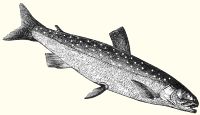

An Occasional Publication for the Home Boat Builder
Glen-L Marine Designs - 9152 Rosecrans Ave. - Bellflower, CA 90706

In this issue
- Featured Design: Sherwood Queen
- On the drawing board: CS 20 update
- Designer's Notebook: Porpoise, what is it?
- Beaufort Force Scale
- Feedback: Two Plus by Kjetil Petersen
- Shop Talk: Working with Half-Section Patterns by Ken Schott
- Feedback: Power Skiff 14 by Ken Muenster
- Recent email
GLEN-L Update
-
Web site:
- No one has yet asked about how the WebLetter works, but I thought I'd throw this out. Links to other pages, either on or off site, that do not have a link back to the starting point, are opened in a separate window. If you close this window, you will be back where you started. Often you can see a larger photo of images in the WebLetter by clicking on them. These images will always have a border around them. You can also tell if the photo is "hot" if your cursor changes to a finger when held over the photo. I haven't mentioned this before, because I think there is some satisfaction in discovering these things for yourself. Probably won't mention it again. I would only add that I am sure that some readers have gotten more out of the WebLetters than others.
- CS 20: Our larger version of the Cabin Skiff is due late June to mid-July.
- This issue of the WebLetter features the Sherwood Queen. The next WebLetter will feature V-drive boats. This would include: Thunderbolt, Hot Rod, Tornado, Missile, Dragster... If you have photos or feedback on these designs with a V-drive, I hope you will share with our readers. A reminder: This section is in response to reader requests. I will try to present as wide an array of designs as possible, attempting to add additional information from what is currently on the site, which can be difficult without your input.
- Thanks to Kjetil Petersen, Ken Schott, Ken Muenster, Graham Knight, Bob Weems, John Knauss and all the others who contributed to this WebLetter.
Editor
Featured Design: Sherwood Queen
There was once a movie... Errol Flynn, Basil Rathbone, Olivia de Havilland... Robin Hood... and there was an English forest located in Southern California. The forest was below a dam... many movies and TV series were shot in the area, but the lake above the dam had its name changed in honor of Sherwood Forest from the Errol Flynn movie. And Glen built a weekend retreat on the lake... the Sherwood Queen was named in honor of Lake Sherwood.
The Sherwood Queen is a displacement hull, with limited hull speed but very economical to run. She is the ideal lake boat, good for touring with friends on a warm summer evening with a hamper containing bread, cheese and a bottle of wine. Or for an early morning or evening run along the shore, casting just short of the reeds, trying to entice the "big one" to your lure.
Frame Kit available
Sherwood Queen Links:
Bob
Bura and Don Fritz's boat
Feedback: Frank Stiles
Robin Hood
On the drawing board: CS 20 update
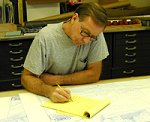
We are we on schedule... kinda. Glen has to calculate the Bill of Materials and Laminate Schedule, then it all has to be proofed. Allyn has started proofing the plans and patterns. Darla and Gayle will proof the instructions for grammar and mistakes, then Allyn and I will proof them against the plans and patterns.
Our tentative due date was the end of this month; we hope to make that, but it may not be complete until mid-July. It all depends on how much time we can devote to it.
We are all aware of the number of builders who have requested plans for "a larger Cabin Skiff", and will try to keep things on schedule.
Designer's Notebook: Porpoise, what is it?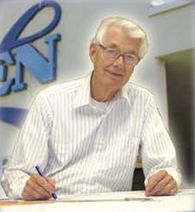
Planing boats can have a condition where the boat "bounces" in the planing attitude and will longitudinally teeter totter back and forth. In severe cases the boat can leap clear of the water. In either case, the ride is rough and uncomfortable. A small amount of porpoise is desirable in faster boats as they shouldn't be glued to the water for maximum speed. For most pleasure boats, a porpoise is a pain in the posterior both literally and actually. Two factors tend to make a planing boat porpoise; weight distribution and/or a warped bottom. Weight distributionA planing boat that has excessive weight at the transom will tend to porpoise. Underway the excess transom weight makes the boat go down by the transom, but then forward speed overcomes the weight and the bow drops, most often slamming down. This condition repeats itself time and again. The boat is simply out of balance. The cure is to remove weight from the transom. Shift any movable weight forward. Batteries, fuel or bait tanks, even passengers if sitting near the transom. Note in this case, weight is REMOVED from the transom, adding weight forward to bring the boat in balance is not desirable. Warped bottomThe fore and aft bottom lines of a fast boat are straight in the aft section; they do not curve upward near or at the transom; commonly called a rocker. Our instructions and drawings generally emphasize the importance of straight lines in this area, but it's easy to goof. We've erred, and we know better. It's easy to let the transom drop down a little when building bottom side up. Don't let it happen; check and recheck. A straight edge along the keel and parallel to it outboard must be straight without gaps between it and the bottom, particularly at the transom. Even a rounded corner at the transom/bottom junction can cause a porpoise. It is common practice to radius this edge when fiberglassing the boat, as the cloth will not readily form around a sharp corner. For top performance, this rounded edge must be eliminated. This is usually achieved by applying additional layers of scrap glass cloth and grinding the edge to a crisp corner. If either of the above conditions are causing porpoising in your boat, the best solution is to correct it. Trim tabs or cavitation plates can also correct the condition, if not too severe. These are often used on faster boats to control bottom defects or disadvantagious weight distribution. |

A couple of questions...
QUESTION:
Can you recommend a small lightweight fishing
boat? I fish in shallow waters, so the boat should not have much draft. I
flyfish and need lots of deck space for casting...
ANSWER:
See: Dragonfly, this boat was designed for your type of
fishing and the stitch and glue method makes it easy to build, requiring
minimumal tools.
QUESTION: ...and I will admit this will come across as a very stupid question! I have purchased a drain plug for the transom. Which way should the plug be installed? That is, should the plug be on the inside of the boat or the outside? After you have stopped laughing, I would appreciate any comments! :) In addition, should this hole be glassed over and then redrilled?
ANSWER:
Glassed over and re-drilled. The plug is normally on the outside. It is
easier to drain the boat if you don't have to get in it to remove the
plug. I talked to Glen about this. My question was, wasn't it easier
to lose on the outside. His reply was yes, "that's why we always
carried an extra".
Beaufort Force Scale
British Admiral Francis Beaufort invented the Beaufort Scale in 1806; it was adopted by the Royal Navy in 1838. The scale was designed to allow weather to be recorded and understood by people who were not present to observe for themselves. Although small changes have been made over the years, the Beaufort scale is still based around Francis Beaufort's original concept. For a more contemporary scale see Useful information and Suppliers.| force 0 | (calm) | = | man-o'-war gives no steerage way |
| force 1 | (light air) | = | man-o'-war gives steergage way |
| force 2 | (light breeze) | = | man-o'-war all sail set in smooth water @ 1 - 2 knots |
| force 3 | (gentle breeze) | = | man-o'-war all sail set, heels gently @ 3 - 4 kn. |
| force 4 | (moderate breeze) | = | man-o'-war all sail set, heels moderately @ 5 - 7 kn. |
| force 5 | (fresh breeze) | = | man-o'-war all sail set, heels considerably @ 7 - 9 kn. |
| force 6 | (strong breeze) | = | man-o'-war furled royals |
| force 7 | (near gale) | = | man-o'-war furled topgallants, single-reefed topsails |
| force 8 | (gale) | = | man-o'-war furled jib, double-reefed topsails |
| force 9 | (severe gale) | = | man-o'-war furled crojack, treble-reefed topsails, single-reefed courses |
| force 10 | (storm) | = | man-o'-war close-reefed main topsail & forecourse (or storm staysails) |
If at first you don't succeed,
skidiving is not for you.
Why is the time of day with the slowest traffic called "rush hour"?
Why didn't Noah swat those two mosquitoes?
...Darla
Feedback: Two Plus
by Kjetil Petersen
I now have had it in the water and I love it. Being a garage built boat, it really performs beautifully. Unlike deep vee hulls it planes out very quickly and has superb directional stability even at moderate speeds. I like boats like this, that can be cruised at about 15 knots. I don't know top speed yet. But a rough estimate is about 25 knots with my four stroke 60hp. The Two Plus is a very spacious boat for its size. I moved the bulkhead about a foot forward compared to plans. This gave some more space in the cockpit. I also installed a portapotti below the bench, inside cabin instead of the enclosed head that was detailed in the plans.
Due to the mahogany laminations, the hull is actually 15mm thick. I was concerned about the total weight. But boat with motor and all the other hardware is only 765 kg.
Thank's to Glen-L for making it possible for amateurs to fulfill their dreams. I am 37 years old. And I first read about Glen-L and boatbuilding when I, as a kid, found some of my father's old Popular Mechanics magazines. They described how to build the Sea Knight and the Swish. I still have these magazines. And the idea of building a boat myself has been around since then.
Shop Talk: Working with Half-Section Patterns
by Ken Schott
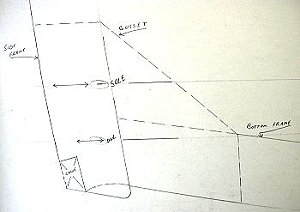
I found the plans for this project somewhat intimidating since it has half-section patterns for the frames. Working with the "other" half was blind to me. I started drawing the frames as in WebLetter 48, and carried the idea a little farther. I purchased a roll of heavy paper from the flooring section at the Home center. It is heavier than kraft paper and white on one side. I covered the bench with this and drew the patterns full size and complete. A drywall scoring square is VERY helpful drawing the centerlines and setup lines. With this I have a working full-size pattern for the workbench.
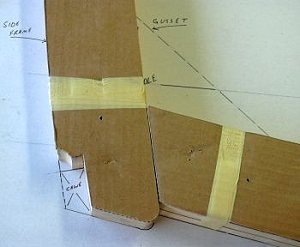
This can also make cutting patterns to use on the bandsaw. I gang cut all my gussets and frames. The transfer of the patterns took several afternoons, but the actual cutting was only a few hours for the whole frame set using my cut patterns on a bandsaw.
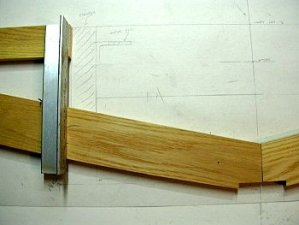
All my assembly was done right on top of the drawing. Drive a finishing nail in the inside corner of the chine/sheer notches and the frames will be captured right-on. Wax paper protects the paper from glue squeeze-out.
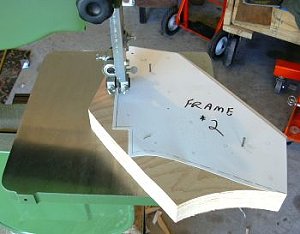
These full-size patterns are useful to go back and reference floors, sole beams, stringers, etc., etc. I now have the actual plans put away, and all I use for the project is my heavy paper full sized patterns.
Maybe this helps some guys,
Ken.
To extend the working time for large lay-ups, (such as D. Eagle +10%
keel, 2 layer lamination), use slow hardener in the cool of the morning.
The low morning temps let the hardener set up really slow.
Ken Schott
Feedback: Power Skiff 14
by Ken Muenster
Enclosed are pictures of my Power Skiff 14 that I have been enjoying for the past month. So far I have been in the area lakes in Alabama and the coastal waters in Florida. I started the project in Oct 2003 and completed and launched it in April 2004 by working weekends and nights. I started out with the original plans as an open hull design, but with some modifications I designed my boat after that of a 17' Console Skiff built by David Ogden, as seen in your Customer Photos, and another 14' Power Skiff built by Tom Schroder.
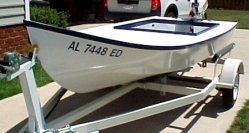
The deck and reinforcement were added to give me access to fly fishing in the area lakes and rivers and shrimping off the coast in the inter-coastal waterways. The boat is very stable and handles the addition very well.
The boat is powered by a 15 HP Johnson tiller and will plane out quickly, reaching a top end speed of approximately 23 MPH. The 6-gallon gas tank is located in the middle bulkhead compartment and adds some weight and balance to the front of the boat.
The cockpit design is very comfortable, accommodates two fishermen and is easily handled by one person when launching and retrieving at the boat ramps. Plenty of storage areas were incorporated into the design in the bow, cockpit storage area and rear deck compartments.
This is my first Glen-L pattern and I am thoroughly enjoying every minute in my first boat. A special thanks to my wife Gail who was their when I needed that extra hand and support. Also, to David and Tom for there endless help and my endless emails and phone calls. And to the guys at work when it came time to flip the boat over, several times.
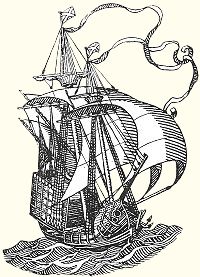
Recent email:
Below is the result of your feedback form. It was submitted on Sunday,
June 6, 2004 at 01:33:22
----------------------------------------------------------------
name: Ronald Helton
Comments: I discoverd this web site from the woodenboat website collection of photos sent in from boat builders and owners. One boat was a Glen-L design. I have enjoyed your catalog of designs for browsing for about fifteen years,and hope to build a sailboat someday. Good selection, and attractive designs, and reasonable prices on plans.
Below is the result of your feedback form. It was submitted on Saturday,
June 5, 2004 at 11:13:00
---------------------------------------------------------------
name: Lee M. Johnson
Comments: I have ordered the plans and patterns for the TNT. I look forward to getting started. This will be a father son project. My son is eight.
Below is the result of your feedback form. It was submitted on Tuesday,
June 8, 2004 at 08:07:31
--------------------------------------------------------------
name: Chris Anthony
Comments: A few days ago I recieved the plans for the Sissy-Do, my first boat project. Now I'm not a stranger to tools or woodworking, honestly, the smell of freshly worked lumber somehow at that moment makes everything in life very good. (especially when my 5 & 9 year old boys turn off the TV or Playstation and say "hey dad, lets go build something"). Anyway, starting this project is all I can think about, heck, I even dreamt about sharpening my planes last night.
Thanks, Chris Anthony, Richmond, VA
Sharpening your planes is a good place to start.
Subject: Building Super Spartan
Date: Sat, 5 Jun 2004
Barry,
I finally got my Super Spartan in the water. Here are a couple pics.
With a warmed over 9.9 Yamaha and a stock 12" pitch aluminum prop
and a 160# driver, we saw 34 m.p.h. which exceeded my expectations. Now
it's time to start tuning the motor and testing props.
Don Slomke
Subject: Tiny Titan project
Date: Sun, 6 Jun 2004
I completed the Tiny Titan last fall.
I started my 13 year-old son out with a '50s classic Mercury Mark 5 outboard, set up with a dead man throttle and stock prop. He drives it easily, and has topped out at 23 mph. Not bad for 5 horsepower!! This was just to get him accustomed to the feel of the boat. We are now working on a classic Mercury 10 Lightening.
Bill Wright
Osterville MA
Subject: Topper Update: Marc Miller
Date: Mon, 31 May 2004
Barry,
I thought that you might like to see my current status:
http://mis.aug.edu/mmiller/boat.htm
I cannot thank you enough for your quick response to all of my questions.
As you can see from the pictures, I have made a fair amount of progress and hope to have the planking complete by the end of the week. I have used some fairing compound that I had left over from redoing my O'Day, however I wish now that I had used your epoxy fillers from the beginning. I ordered some this morning.
So far, the hardest aspect (for me) has been the planking process. Making those planks fit adequately is tough and a little bit slower than I thought. However, I think that the hardest part is behind me.
I redid the bottom of my O'Day 28 last year, so I think that I will be able to handle the fiberglassing, although your video sure answered a lot of questions that I had. With the heat here in Augusta, I will have to get up and fiberglass the boat at about 5:30 am!
I will keep you updated. I believe that I will be able to turn her over by June 15th.
Have a good Memorial Day.
Sincerely,
Marc
Subject: Project Registry update
Date: Mon, 31 May 2004
One of your readers has informed me that my email and URL information are out of date. Could you please change my entry in your Project Registry to read as follows?
WANDERLUST / Anthony Ciarochi / Browns Point, WA / Check my progress at http://www.ivplanet.net/~ciarochi/boat/Wanderlust.html (continually updated)
Thank you!
Anthony Ciarochi
Below is the result of your feedback form. It was submitted on Friday,
May 28, 2004 at 01:21:49
---------------------------------------------------------------
name: Chuck Corrigan
Comments: What a great website you have! I first heard of your company by seeing an advertisement in the back of a magazine when I was about 8 years old, and ordered a design catalog right away. I'm now 32, and I still have the catalog!! I built a stitch and glue kayak a couple of years ago, and I'm now considering beginning a powerboat runabout (Mist Miss perhaps?). I look forward to reading the newsletter archives and using the bulletin board.
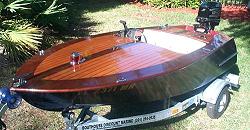
From: Bob Weems
Subject: POST MAN COMPLETED 5/15/04
Date: Mon, 24 May 2004
Below is the result of your feedback form. It was submitted on Sunday,
May 23, 2004 at 02:18:27
--------------------------------------------------------------
name: John Knauss
Comments: In 1958 my father and I built a Glen L Dragster from plans. We installed a 1958, 430 cu. in. Mercury auto engine. After a couple or so years we removed the 3 two barrel Holley's that came with the engine and put on an "Edelbrock" log intake manifold with 6 two barrel Holley's. This was a fuel quantity change to accommodate the "Clay Smith" camshaft with mechanical lifters. We followed through with a "Joe Hunt", "Vertex" magneto with its timing advance curve tailored to the engines requirements. The engine with this setup proved to be a nice combination for the boats enjoyable performance.
At first we used a direct drive Walter's V-Drive. This brand had a good name for holding up with big engines. When the Walter's Forward, Neutral and Reverse V-Drive became available, we traded the direct one in. The transmission has a 13% over-drive gear ratio. This propeller shaft is 1" O.D. Monel turning a cupped 13" O.D., 16 pitch, Federal stainless steel propeller.
The back seat faces forward in front of the engine compartment's two re-moveable hatch covers. The sides are 3/ 8", deck 1/4", and the transom 1/2", all marine Mahogany plywood. The bottom is 1/2" marine fir plywood. All frame work is Philippine Mahogany.
I still have the boat and enjoy it with my family water skiing. Most of our time with the boat is spent at Shasta Lake water skiing with our family and friends.
Thank you for a great long lasting design.
John Knauss
Below is the result of your feedback form. It was submitted on Wednesday,
May 19, 2004 at 08:00:35
----------------------------------------------------------------
name: Ed Delapp
Comments: When I was a youngster I was crazy about the sea, ships, and
especially about those who built their own boats. I never had the
opportunity to own one, but I am nearing retirement now and I will
fulfill my dream of building a boat and sailing off the coast. That is my
goal anyway...
I'm mainly interested in sailboats. I will be close to the Hudson
River and my intentions will be to build and sail down the New Jersey
shore to North Wildwood where I share a summer home. I look foward to
your articles and since I remember your company from way back, you seem
like an old friend.
From the Boatbuilder Connection... just in case you have doubts about the expertise of our posters...
Posted: Fri May 14, 2004 2:10 am
Post subject: two great nations
ahh yes, England and America. Two great nations separated by a common
language!
one of my favorites:
ok "Bollocks" is bad, right? Then how the *ell can "Dogs
Bollocks" be good?!
Guest
Posted: Fri May 14, 2004 4:46 am
Post subject: Re: two great nations
Anonymous wrote:
ok "Bollocks" is bad right? then how the *ell can "Dogs
Bollocks" be good?!

That's an easy one, I expect you know anyway but I'll explain...
The word "bollock", according to the dictionary, literally
means a small round object and in its plural form is commonly used in
reference to certain parts of the male anatomy. In recent times,
"bollocks" has also been used to mean rubbish or nonsense, in
which case it is of course a bad thing.
In the context of "the dog's bollocks" it's a good
thing. If you've ever watched a male dog and noticed the amount of
attention they pay to them, you'd realise that to the dog they must
be something pretty special!
And just in case anyone should think that the word bollocks is a swear word, in the late 1970s a High Court judge ruled that it wasn't. In a case involving attempts to get the album "Never Mind The Bollocks, Here's The Sex Pistols" withdrawn from shops, he ruled that it simply meant a "load of rubbish" and was, therefore, inoffensive.
Amazing what you can learn on a boatbuilding forum isn't it?
_________________
Graham in Shepperton, England
Subject: Re: Glen-L Update
Date: Fri, 14 May 2004
Thanks Glen-L I always look forward to your Updates. Russ Shields
Build more boats
GLEN-L boats, of course

